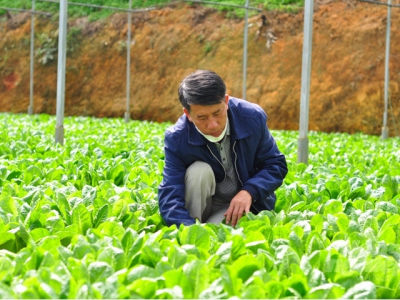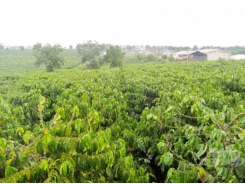Flower and vegetable production in Da Lat gear up for year-end demand

After the social distancing measures have been eased and the markets have resumed trading, farmers in Da Lat City have also embarked on production activities.
Da Lat farmers embark on re-production after the pandemic. Photo: Minh Hau.
These days, vegetable and flower growers in Thai Phien flower village (Ward 12, Da Lat City, Lam Dong Province) are focusing on improving their fields and gardens, sowing seeds in preparation for the winter-spring crop and especially for the upcoming Lunar New Year.
According to Nguyen Dinh Cung, a daisy grower, the COVID-19 pandemic has seriously affected the revenue from the local gardens. Flowers could not be sold, making the revenue un able to cover expenses
Currently, as the pandemic is basically under control, the domestic markets have started to demand flowers again so his family has been concentrated in investment and production.
He said: “Recently, my family tried to preserve the flower crop for the full moon of September (September 15 of the lunar calendar) and luckily the market reopened. Flowers are sold evenly at a high price so we have earned a significant income. After this batch of flowers, we will focus on producing flowers to supply for the demand in the last months of the year, especially for the Lunar New Year market."
Also in Ward 12, Nguyen Thi Hue's family is focusing on improving their garden and starting to plant vegetables. They mainly grow lettuce and crown daisies in their gardens. During the outbreak of the COVID-19 pandemic, the social-distancing measures were implemented within the region, which made them unable to sell vegetables and suffer from loss. Nearly 2 hectares of their garden have been almost left empty since August. Currently, as the markets are gradually re-opening, she has embarked on reinvesting and planting new crops.
Tan Tien General Agricultural Service Cooperative in Ward 12 is also implementing a series of post-epidemic production plans. According to Mai Van Khan, director of the cooperative, the total area that is jointly cultivated by both the cooperative and local farmers is about 80ha, growing vegetables of all kinds with an annual output of thousands of tons.
During the forth outbreak of the epidemic, specifically from June to August, the cooperative's vegetable consumption channel was broken and about 70 tons of vegetables could not be sold.
“The cooperative is organising the cultivation of vegetable varieties such as carrots, potatoes, onions, bell peppers, while increasing the area of short-term leafy vegetables to ensure meeting orders from the wholesale markets in HCMC,” he said.
He added that the markets are re-opening with high demand for goods, so the production of the cooperative is not sufficient to meet demand. Many vegetables are not stocked enough to supply partners even though the prices are many times higher than usual.
“During the pandemic months, the cooperative maintained production despite the difficulty of inputs such as fertilizers and agricultural materials. After the pandemic, we have drawn lessons in production and response to unusual phenomena. Currently, we plan to produce according to orders, ensuring the input factors for active production.
We have also been specialised on vegetables, tubers and fruits suitable for current conditions and preliminary processing, processing and preservation…”, the director continued.
Meanwhile, flower growers in Thai Phien Village have also embarked on re-production after the pandemic. Many gardeners specializing in chrysanthemums, lilies, carnations... have sown seeds to prepare for the year-end market, especially the Lunar New Year.
Nguyen Thanh Cung, a senior daisy grower in the village, revealed that his family suffered heavy loss in recent months, as they cut more than 2,000 square meters of daisies.
At the beginning of October, the market started to recover, so his family borrowed money to reinvest and re-produce flowers.
According to Dang Bao Vinh, Chairman of the Farmers' Association in Ward 12 (Da Lat City), the locality has a large area of growing vegetables and flowers. During the outbreak of the COVID-19 pandemic, many vegetable and flower producing families were severely affected.
Currently, the pandemic has been basically controlled and social distancing measures have been eased so local vegetable and flower have been consumed again at relatively good prices.
Meanwhile, the garden areas that were left vacant during the pandemic have been renovated, sown, and restored by farmers. Long-lasting flowers such as daisies and lilies have been two main kinds of flowers being planted by local farmers to serve the Lunar New Year demand.
“The locality is going to plant lilies on about 12-15 hectares of land to prepare for the Lunar New Year markets. Production has been promoted but farmers are facing difficulties in capital and seed sources. Lily farmers have to order seeds from abroad and deposit money in advance so it is difficult for households who have lost money during the pandemic to reinvest. Therefore, it is estimated that about 30% of farmers have difficulties in obtaining seeds. Meanwhile, many local daisy seed producers cannot maintain activities during the pandemic, so the source of daisy seeds for Lunar New Year production is also about 20-30% short," said Dang Bao Vinh, Chairman of the Ward 12 Farmers' Association.
Có thể bạn quan tâm
Phần mềm

Phối trộn thức ăn chăn nuôi

Pha dung dịch thủy canh

Định mức cho tôm ăn

Phối trộn phân bón NPK

Xác định tỷ lệ tôm sống

Chuyển đổi đơn vị phân bón

Xác định công suất sục khí

Chuyển đổi đơn vị tôm

Tính diện tích nhà kính

Tính thể tích ao hồ



 VnSAT helps to reduce the number of rice…
VnSAT helps to reduce the number of rice…  Businesses plan to recover the production
Businesses plan to recover the production